Platycephalidae
The Platycephalidae are a family of marine fish, most commonly referred to as flatheads. They are relatives of the popular lionfish, belonging to the order Scorpaeniformes.
| Platycephalidae | |
|---|---|
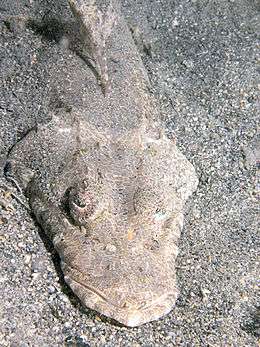 | |
| Sunagocia otaitensis | |
| Scientific classification | |
| Kingdom: | |
| Phylum: | |
| Class: | |
| Order: | |
| Family: | Platycephalidae T. N. Gill, 1872 |
| Genera[1] | |
Members of the family can be found naturally in coastal waters throughout the Indo-Pacific. A few species have been caught in the eastern Mediterranean, having traveled there from the Red Sea through the Suez Canal.
Description
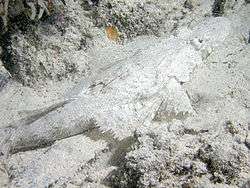
Platycephalids are small to medium-sized fish. Most species are small, reaching an average of 10 cm in length. However, a few species in the genus Platycephalus are known to grow up to a meter in length.[2] Their most distinctive characteristic is the flattened shape of their heads. While the rest of their bodies is shaped similarly to other fish that inhabit the areas they frequent, their heads are triangle-shaped and dorsoventrally depressed, giving them the shape of a trowel or an artist's spatula.[3] Their eyes are situated on the upper surface, in accordance with their bottom-dwelling lifestyle. They possess two complete dorsal fins, the first one supported by six to 9 strong spines.
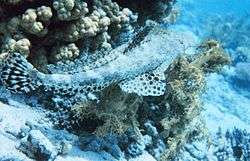
Flatheads are mostly marine demersal fish, often resting directly on the seabed, sometimes partially buried in sand or mud. They can be found in a wide range of depths, ranging from 10 m to the edge of the continental shelf at depths of about 300 m (980 ft).[3]
Flatheads are carnivorous, feeding on small fish and crustaceans. They lie in wait buried by sand, with only their eyes poking out from the substrate. When prospective prey walks or swims close to the platycephalid's head, the flathead strikes rapidly, engulfing the prey in its large mouth. As flatheads are ambush predators they are expected to be relatively sedentary and not move large distances as adults. However, recent research has shown that part of the population of some flathead species makes long distance movements or spawning migrations.[4][5]
Active commercial fisheries are geared towards members of the family. In Japan, some species are the subject of experimental aquaculture programs. Flatheads are commonly caught on rod and line.[6] The larger species are considered game fish.
The name of the family is derived from the Greek words platy, meaning "flat", and kephale for "head".
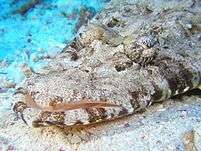
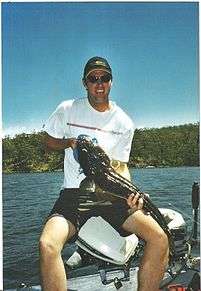
References
- Froese, Rainer, and Daniel Pauly, eds. (2012). "Platycephalidae" in FishBase. December 2012 version.
- IMAMURA, HISASHI (6 January 2015). "Taxonomic revision of the flathead fish genus Platycephalus Bloch, 1785 (Teleostei: Platycephalidae) from Australia, with description of a new species". Zootaxa. 3904 (2): 151. doi:10.11646/zootaxa.3904.2.1.
- Eschmeyer, William N. (1998). Paxton, J.R.; Eschmeyer, W.N. (eds.). Encyclopedia of Fishes. San Diego: Academic Press. p. 177. ISBN 0-12-547665-5.
- Fetterplace, Lachlan C.; Davis, Andrew R.; Neilson, Joseph M.; Taylor, Matthew D.; Knott, Nathan A. (28 July 2016). "Active acoustic tracking suggests that soft sediment fishes can show site attachment: a preliminary assessment of the movement patterns of the blue-spotted flathead (Platycephalus caeruleopunctatus)". Animal Biotelemetry. 4 (1). doi:10.1186/s40317-016-0107-6.
- Hindell, Jeremy S. Gippsland Lakes dusky flathead tracking project. vfa.vic.gov.au. Victorian Fisheries Authority. ISBN 978-1-74208-860-0. Retrieved 15 December 2017.
- Stewart, J (2015). "STATUS OF FISHERIES RESOURCES IN NSW 2013-14". NSW Fisheries Reports: 391. Retrieved 15 December 2017.
- "Platycephalidae". Integrated Taxonomic Information System. Retrieved 21 February 2007.
- Myers, P.; R. Espinosa; C. S. Parr; T. Jones; G. S. Hammond; T. A. Dewey (2006). "Platycephalidae". Animal Diversity Web. University of Michigan Museum of Zoology. Retrieved 2007-02-21.